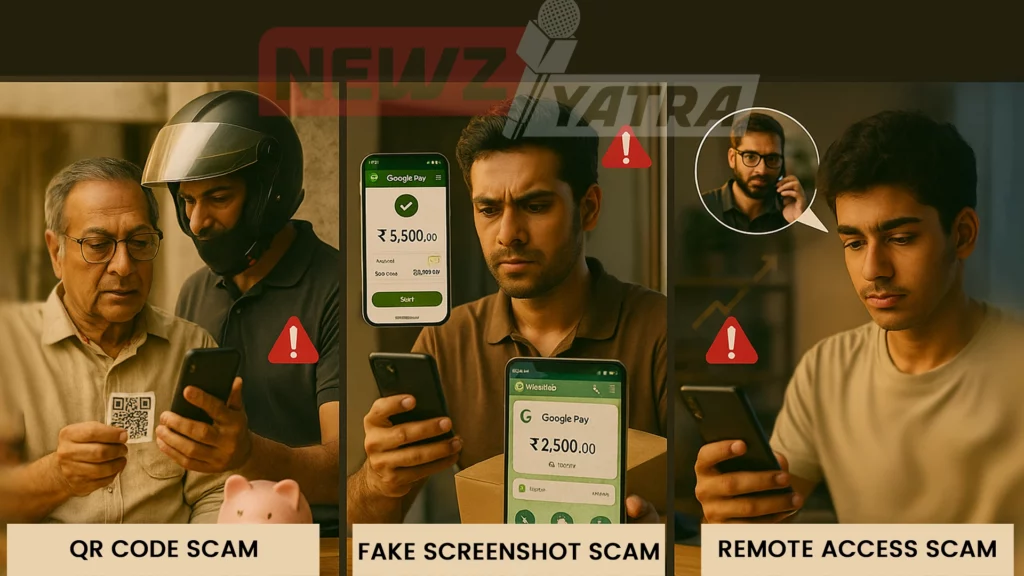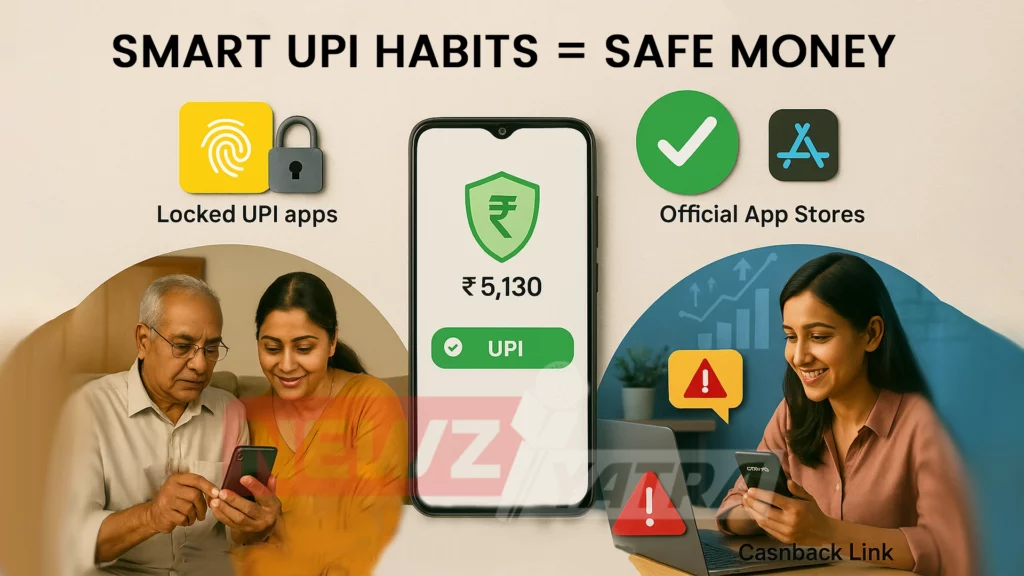UPI Frauds in 2025: How to Stay One Step Ahead of Scammers

Unified Payments Interface (UPI) has revolutionized the way India transacts—enabling quick, seamless, and cashless payments for everyone, from small neighborhood vendors to large enterprises. But with growing convenience comes increasing vulnerability.
In 2025, UPI frauds have become more sophisticated, quicker to execute, and harder to detect. A single moment of carelessness can wipe out your hard-earned money. upi frauds in india
In this blog, we’ll break down:
- The latest and most common UPI scam techniques
- Real-world incidents that show how users are being targeted
- Practical, proven tips to safeguard yourself from falling victim
Stay informed. Stay secure.
What Is UPI Fraud?(upi frauds in india)
UPI fraud refers to any deceptive activity where scammers exploit the Unified Payments Interface (UPI) system to steal money from unsuspecting users. These frauds typically involve unauthorized transactions carried out through manipulation, impersonation, or technological loopholes—often without the victim realizing what’s happening until it’s too late.
Cybercriminals use a variety of tactics, including:
- Phishing links that trick users into entering sensitive information
- Fake customer support numbers that lead to screen-sharing or OTP theft
- Cloned UPI apps designed to mimic legitimate ones like Google Pay, PhonePe, Paytm, and BHIM
- Malicious QR codes that debit money instead of receiving it
- Social engineering tactics, such as posing as a buyer/seller on platforms like OLX, WhatsApp, or Instagram
The goal is always the same: to manipulate you into unknowingly authorizing a payment, often under the guise of receiving one. Once the money is transferred, it’s nearly impossible to get it back—making prevention your best defense.
Mutual Funds vs Fixed Deposits: Will Your Money Grow or Disappear
common UPI Scam Techniques in 2025 (upi frauds in india)
As UPI (upi frauds in india) usage continues to grow across India, so do the tactics of cybercriminals. In 2025, UPI fraudsters are using smarter, more convincing methods to trick users. Here are some of the most prevalent scams happening today—and how you can avoid becoming the next victim.
1. Fake Customer Support Numbers
How it works:
Scammers create and promote fake customer service numbers for popular UPI apps like Google Pay, PhonePe, or Paytm. These numbers often appear in Google search results, social media posts, or unofficial websites. When you call, the scammer pretends to be a customer service agent and asks you to scan a QR code or share sensitive details like your OTP or UPI PIN. (upi frauds in india)
Once you follow their instructions, your money is instantly transferred out of your account.
Real-life scenario:
Ravi, a small business owner in Delhi, searched for “PhonePe customer care” on Google and dialed the first number he found. Within minutes of following the agent’s instructions to “verify his account,” ₹20,000 was debited from his UPI wallet. (upi frauds in india)
Tip:
Never search for customer care numbers online. Use the official help section within the app. Legitimate support will never ask for your OTP or QR code scan.
2. QR Code Scams
How it works:
This scam typically happens on resale platforms like OLX, Quikr, or Facebook Marketplace. Fraudsters pose as interested buyers and send a QR code, claiming it’s to send you money. In reality, the QR code is designed to make you pay them. (upi frauds in india)
If you scan the code, thinking you’re receiving a payment, the money actually goes to the scammer’s account.
Real-life scenario:
A woman in Pune selling her sofa on OLX received a QR code from a “buyer.” She scanned it and instantly lost ₹15,000 from her account—thinking she was about to receive it.
Tip:
You never need to scan a QR code to receive money. Always ask for a direct UPI transfer to your number or UPI ID. (upi frauds in india)
3. Remote Access Apps
How it works:
Scammers convince users to download remote access tools like AnyDesk, TeamViewer, or QuickSupport, under the pretense of solving a technical issue. Once installed, these apps give the fraudster full control of your phone. They can see everything you type, including your UPI PIN, and even initiate transactions.
Real-life scenario:
After posting a complaint on Twitter about a failed transaction, Rajiv was contacted by someone claiming to be from Paytm support. They asked him to install AnyDesk to “resolve the issue.” Within 10 minutes, ₹50,000 vanished from his account.
Tip:
Never install remote access apps unless you fully understand the risk. No bank or UPI app (upi frauds in india) will ever ask you to download such tools.
4. Fake Payment Screenshots
How it works:
Scammers pretending to be buyers show you fake screenshots of (upi frauds in india) UPI payments—complete with fake transaction IDs and timestamps. Thinking the payment is done, you hand over the goods or service. Only later do you realize the money never reached your account.
Real-life scenario:
A freelance photographer was paid using a fake (upi frauds in india) Google Pay screenshot after a shoot. By the time he noticed, the client had blocked him and disappeared.
Tip:
Don’t rely on screenshots. Always check your actual UPI app transaction history or SMS alerts from your bank.
5. Job Offers & Cashback Scams via Links
How it works:
Scammers send messages promising job opportunities, lottery wins, or instant cashback (e.g., “Click here to claim ₹50”). These links often lead to phishing websites that look like real bank or UPI (upi frauds in india) login pages. Once you enter your UPI ID, PIN, or OTP, the scammers capture the data and drain your account.
Real-life scenario:
A college student received a WhatsApp message with a link to a “₹100 Paytm cashback” offer. He clicked the link and entered his UPI credentials. Minutes later, ₹7,500 was gone.
Tip:
Avoid clicking on links from unknown numbers or emails. If an offer sounds too good to be true, it probably is. Always verify through official channels.
What Is Life Insurance? A Simple Guide

How to Protect Yourself from UPI Frauds
With the rise of digital payments, especially through UPI,(upi frauds in india) protecting your financial data has never been more critical. Scammers are becoming increasingly creative and sophisticated—but the good news is that most UPI frauds can be prevented by staying alert and taking a few simple precautions.
Here are some essential steps to safeguard yourself:
1. Enable UPI App Lock
Why it matters:
Most UPI apps like Google Pay, PhonePe, and Paytm allow you to add a security lock using a fingerprint, Face ID, or a password. This ensures that even if someone gets physical access to your phone, they cannot open the app or initiate transactions without your authentication.
What to do:
- Go to the app settings and enable “App Lock” or “Biometric Lock.”
- Use a strong phone lock (PIN/Pattern/Face Unlock) as a first layer of defense.
- Avoid sharing your phone with strangers.
Bonus Tip: If your phone is lost or stolen, immediately use your bank or UPI app’s “remote disable” or block option.
2. Never Share UPI PIN or OTP
Why it matters:
Your UPI PIN (upi frauds in india) and OTPs are strictly confidential—they are digital equivalents of your ATM PIN. No legitimate customer care executive, banker, or service provider will ever ask for them.
What scammers do:
They’ll pose as bank officials or tech support, often creating a sense of urgency (“Your account will be blocked!”) to make you panic and share the OTP or PIN. (upi frauds in india)
What to do:
- Hang up or ignore anyone asking for sensitive data.
- Educate family members—especially elders and teens—about this rule.
- Use multi-factor authentication wherever possible.
3. Use Only Official Apps
Why it matters:
There are hundreds of cloned or modified apps that look exactly like Google Pay, PhonePe, BHIM, or Paytm but are actually malware. These fake apps capture your login info and forward it to cybercriminals.
What to do:
- Download apps only from trusted sources like the Google Play Store or Apple App Store.
- Never download APK files or app links shared over WhatsApp, SMS, or Telegram.
- Regularly update your apps to patch security flaws.
Bonus Tip: Read user reviews before downloading any finance-related app.
4. Check URLs Carefully
Why it matters:
Phishing websites are designed to trick you by mimicking legitimate domains. The URLs might look familiar but usually have subtle misspellings or added characters (e.g., gpay-supports.in instead of google.com/pay).
What scammers do:
They send fake job offers, cashback campaigns, or KYC updates via SMS/WhatsApp with fraudulent links that steal your login details.
What to do:
- Double-check every URL before clicking—especially if it’s asking for financial info.
- Look for “https” and a padlock icon in the browser.
- When in doubt, type the website directly into your browser instead of clicking a link.
5. Report Suspicious Activity Immediately
Why it matters:
If you suspect fraud or notice an unauthorized UPI transaction, time is critical. The sooner you report it, the higher the chances of recovery.
Where to report:
- Your bank or UPI app: Most have a “Report fraud” option or toll-free number.
- National Cyber Crime Portal: https://cybercrime.gov.in
- Helpline Number: Dial 1930 – the Indian cyber fraud helpline.
What to do:
- Collect transaction details (date, time, amount, reference ID).
- Take screenshots and lodge a complaint on the cybercrime portal.
- File a police report if necessary for large losses.
Best Health Insurance Plans in India (2025): Compare & Choose Wisely!

Why UPI Frauds Are Rising in 2025
UPI has become a daily necessity for millions across India—but this rapid adoption has also opened the floodgates for fraud. (upi frauds in india) Here’s why scams are more common and dangerous than ever in 2025:
1. Mass Adoption by First-Time Users
With UPI reaching deep into rural and semi-urban areas, many users are new to digital finance and unaware of fraud risks. This makes them easy targets for scammers. (upi frauds in india)
2. Smarter, AI-Driven Scams
Fraudsters now use AI to create convincing fake messages, cloned voices, and even deepfake videos—making scams harder to detect and more personal than ever. (upi frauds in india)
3. Cloned Apps & Fake Links
Lookalike UPI apps and phishing links are becoming more sophisticated, tricking users into sharing sensitive info like UPI PINs or OTPs.
4. Overtrust in Screenshots & QR Codes
Many users still accept payment screenshots as proof or scan QR codes to “receive” money—common traps that lead to instant losses.
5. Low Awareness, Especially Among Seniors
Older adults and less tech-savvy users often fall for impersonation or urgency-based scams, such as fake bank calls or job offers. (upi frauds in india)
Final Swipe: Outsmart the Scam Game
In a world where digital convenience meets digital deception, staying one step ahead of UPI fraudsters is no longer optional—it’s essential. As we move deeper into 2025, (upi frauds in india) scams have become smarter, faster, and harder to spot, but that doesn’t mean you have to fall for them. The truth is, scammers don’t win because they’re geniuses—they win because people aren’t prepared.
By staying alert, questioning every unexpected link or call, never trusting payment screenshots, and treating your UPI PIN and OTP like your most guarded secrets, you can turn the tables. Lock your apps, verify every transaction, and educate those around you—especially seniors and first-time users. In this digital age, awareness is your strongest defense, and a few extra seconds of caution can save you from weeks—or even months—of regret. Stay informed, stay skeptical, and most importantly, stay safe. (upi frauds in india)
Your UPI safety is in your hands—don’t give scammers the upper hand.
Think of this blog as your digital shield. Now it’s time to pass it on. Share it with your parents, friends, colleagues—even that one cousin who clicks every cashback link! Let’s outsmart the scammers, one informed user at a time.
=> Want more tips to stay scam-proof in the digital age? (upi frauds in india)
=>Subscribe to our updates, follow us on social media, and join the tribe of smart, secure UPI users.
🛡️ Because in 2025, awareness isn’t just power—it’s protection. (upi frauds in india)
What Is Insurance? Complete Guide to All Types of Insurance Explained Simply!
(FAQs)
1. What should I do if I become a victim of UPI fraud?
Immediately take these steps:
- Contact your bank or UPI app support and report the transaction.
- Call the cyber fraud helpline: 1930 (India).
- File a complaint at the official Cyber Crime Portal: https://cybercrime.gov.in
- Save transaction details, take screenshots, and keep your complaint number for follow-up.
2. Can money lost through UPI fraud be recovered?
Recovery is possible, but only if reported quickly. As per RBI and NPCI guidelines, reporting within 24 to 72 hours improves chances of freezing and retrieving funds. Delays reduce your chances significantly.
3. How can I check if a customer care number is real or fake?
Always:
- Use the official app help section (Google Pay, PhonePe, Paytm, etc.).
- Avoid numbers found through Google search, WhatsApp forwards, or random websites.
- Legitimate support will never ask for OTPs, UPI PINs, or to scan a QR code.
4. Is it safe to scan a QR code to receive money?
No.
You should never need to scan a QR code to receive money. Scanning a malicious QR often leads to money being debited from your account. Ask for a direct UPI transfer to your mobile number or UPI ID instead.
5. What are signs that a UPI payment screenshot is fake?
Fake screenshots often:
- Are sent quickly before you check your balance
- Use fake transaction IDs or reused timestamps
- Come with a story to create urgency
Always confirm in your UPI app’s transaction history or via SMS alert—not through screenshots.





